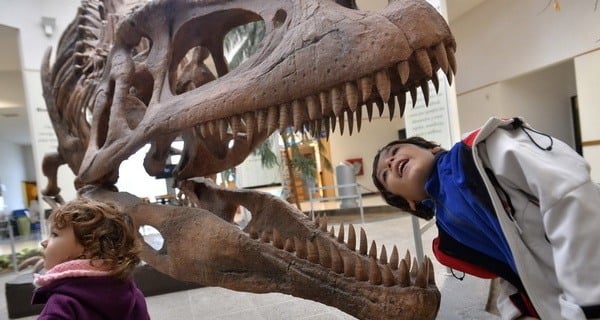Unlocking the Devastating Power: Just How Ferocious Was a T. Rex’s Bite?
Ever wondered just how much raw power that giant chomping machine, the Tyrannosaurus rex, packed between those famously banana-sized teeth? Well, until recently, scientists only had guesses – and let me tell you, “guess” doesn’t quite cut it when you’re talking about a dino that literally ruled the prehistoric food chain. Thanks to a wild new study that enlisted the help of some seriously cranky 17-foot-long crocs (yes, actual living bite-testers!), we finally got a jaw-dropping number: around 8,000 pounds of bite force. That’s like having three tiny cars parked on your jaw, crushing bones without breaking a sweat. And the pressure on some individual teeth? A whopping 431,000 pounds per square inch – making human chewing look embarrassingly weak. How did they pull this off? By diving into the T. rex’s closest modern cousins, the crocodiles, and then cooking up 3-D models that let us peek inside the ferocious bite mechanics of history’s most fearsome predator. But hey, the story gets even juicier when you learn that some prehistoric crocs likely trumped T. rex with double the bite force – though lucky for the T. rex, these mega-biters never crossed paths. Intrigued yet? Dive deeper into the crunching power of T. rex’s bite right here: LEARN MORE
A new study used alligators to reconstruct the bite power of the most fearsome dinosaur.

Wikimedia Commons
It seems obvious that you wouldn’t want to get caught between the banana-sized chompers of the history’s most famous dinosaur.
Until recently, though, scientists were unsure of just how thoroughly a Tyrannosaurus rex could mash your bones into pulp. Thanks to a paper in Scientific Reports, that mystery has been solved.
“What we came up with were bite forces of around 8,000 pounds,” one of the study’s authors, Gregory Erickson, told NPR. “That’s like setting three small cars on top of the jaws of a T. rex — that’s basically what was pushing down.”
And some of the individual teeth could exert even stronger pressures of 431,000 pounds per square inch. That kind of force makes humans’ 200-pound chewing power seem embarrassingly weak.
Erickson and his colleague arrived at this conclusion by looking at the closest living T. rex relative we have today: crocodiles.
To gather data, researchers lassoed 17-foot crocs and convinced them to bite on a scientific scale in a process that Erickson called “bull-riding for scientists.”
They then took those measurements (which — coming in at 3,700-pounds — reaffirmed the crocodile’s title as biting champion of the animal kingdom today) and used them to create 3-D computer models with T. rex skeletons.
These models confirmed the ease with which the T. rex could eat bones, a skill uncommon for modern reptiles.
“It was this bone-crunching acumen that helped T. rex to more fully exploit the carcasses of large horned-dinosaurs and duck-billed hadrosaurids whose bones, rich in mineral salts and marrow, were unavailable to smaller, less equipped carnivorous dinosaurs,” Paul Gignac, an assistant professor of Anatomy and Vertebrate Paleontology, told Popular Mechanics.
Even with this power, though, the T. rex was probably not the best chewer to ever walk the earth.
Extinct species of humongous crocodile, measuring between 35 and 40 feet, likely bit with 18,000 pounds of force, researchers say — double that of the strongest dinosaur.
Lucky for T. rex, they never lived at the same time.
After learning about the unbelievable bite of the T. rex, check out Nodosaur, the dinosaur mummy recently discovered with its skin and guts intact. Then, learn about the dinosaur-like “sea serpent” fossil found with a baby in its belly.


















